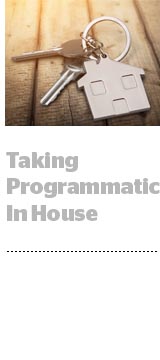
More marketers are moving programmatic strategy in-house, pushing agencies into an executional role, according to a study released by the Association of National Advertisers on Monday.
Most marketers approach in-housing in a hybrid fashion, splitting responsibilities between their internal team and an external agency partner. Marketers increasingly are taking responsibility for strategy while agencies serve a “button-pushing” role, the ANA found.
In a survey of 149 marketers, 35% of respondents told the ANA they have reduced the work they outsource to agencies as a result of expanding their in-house programmatic capabilities. That figure is up from 14% in 2016.
“This confirms that marketers are taking more control of programmatic,” said Bill Duggan, group EVP at the ANA. “The wave has started.”
Sixty-nine percent of marketers, for example, handle strategy and campaign direction in-house. Most marketers have at least one staff member who dedicates 100% of their time to programmatic. And 47% of marketers own their technology contracts, while 43% leave contract ownership to their agencies.
Meanwhile, just 11% of marketers have taken campaign execution in-house. That’s a shift from in-housing models of the past, where agencies would handle strategic work and marketers would take lower-level functions like collateral in-house as a cost-cutting measure, Duggan said.
“Increasingly, we’ve heard that the talent at in-house agencies produce good work,” he said. “Agencies are continually challenged to show their value in a world of hyperfragmentation.”
Still, most agencies retain the reporting and analytics functions that come hand-in-hand with programmatic. Fifty-four percent of marketers leave audience planning to agencies, while 78% let agencies handle post-campaign reporting and 73% let agencies do analysis during campaigns.
But marketers should be wary of jumping into a fully in-sourced model. While taking programmatic in-house is viable for big brands like L’Oreal, Netflix and EA, most marketers – especially smaller ones – will struggle without help from an agency, Duggan said.
“Movement of programmatic in-house has been thoughtful and concentrated among bigger clients because there is a fair amount of infrastructure internally that needs to be assembled,” he said. “It’s not for the faint of heart.”
Opacity Persists
Marketers are adopting in-house programmatic functions more quickly mainly due to continued concerns about transparency and brand safety.
According to Monday’s report, just 40% of marketers are “comfortable or very comfortable” with the transparency of their programmatic buys, with a third stating they are “uncomfortable or very uncomfortable” with programmatic due to hidden costs, an excess of middlemen and little to no insight on where their ads run. Seventy-eight percent said they are “concerned or very concerned” about brand safety in programmatic.
“I have a lack of understanding of the day-to-day management of our programmatic spend with agencies and lack of transparency into optimization and planning,” one marketer told the ANA.
As a result, marketers are opting against nondisclosed buys. Nineteen percent of marketers surveyed have a nondisclosed programmatic model with their agency, down from 34% last year.
“There still are transparency concerns with programmatic,” Duggan said. “The reason why anything would move in-house would be increased transparency, and what’s associated with increased transparency is likely lower costs.”
If marketers do opt in to a nondisclosed agency relationship, they should work provisions into their contracts demanding access to log-level data for programmatic buys. So far, not enough marketers are asking for this level of insight, Duggan said.
“Most don’t know to ask, and only few are doing it,” he said. “At this point we’re simply trying to drive awareness.”
Despite concerns with the programmatic supply chain, marketers are shifting more dollars to the medium because it offers better audience targeting, the ability to build reach and real-time optimization. Of the marketers surveyed, 85% are buying programmatically.
“Efficiency and targetability have certainly accelerated the growth of programmatic,” Duggan said. “More marketers are becoming comfortable with programmatic, but it takes a while to get there.”
This post was syndicated from Ad Exchanger.

More Stories
Beyond Cookies: Using Location Intelligence To Power Privacy-First Audience Segmentation
Scope Media rebrands as Scope Communications
Alphabet Grows Search and YouTube Revenue by Double Digits Amid Increased Competition